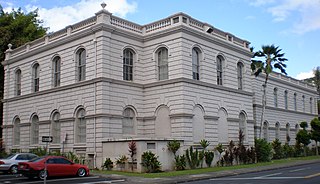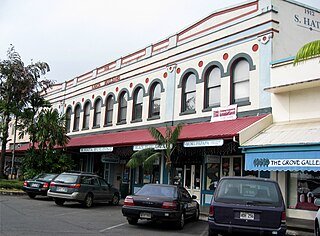
The ʻIolani Palace was the royal residence of the rulers of the Kingdom of Hawaiʻi beginning with Kamehameha III under the Kamehameha Dynasty (1845) and ending with Queen Liliʻuokalani (1893) under the Kalākaua Dynasty. It is located in the capitol district of downtown Honolulu in the U.S. state of Hawaiʻi. It is now a National Historic Landmark listed on the National Register of Historic Places. After the monarchy was overthrown in 1893, the building was used as the capitol building for the Provisional Government, Republic, Territory, and State of Hawaiʻi until 1969. The palace was restored and opened to the public as a museum in 1978. ʻIolani Palace is the only royal palace on US soil.

The Cathedral Basilica of Our Lady of Peace is the mother church and cathedral of the Diocese of Honolulu.

Mauna ʻAla in the Hawaiian language, is the Royal Mausoleum of Hawaii and the final resting place of Hawaii's two prominent royal families: the Kamehameha Dynasty and the Kalākaua Dynasty.

Kawaiahaʻo Church is a historic Congregational church located in Downtown Honolulu on the Hawaiian Island of Oʻahu. The church, along with the Mission Houses, comprise the Hawaiian Mission Houses Historic Site, which was designated a U.S. National Historic Landmark (NHL) in 1962. In 1966 it and all other NHLs were included in the first issuance of the National Register of Historic Places.

Washington Place is a Greek Revival palace in the Hawaii Capital Historic District in Honolulu, Hawaii. It was where Queen Liliʻuokalani was arrested during the overthrow of the Hawaiian Kingdom. Later it became the official residence of the governor of Hawaii. In 2007, it was designated as a National Historic Landmark. The current governor's residence was built in 2008 behind the historic residence, and is located on the same grounds as Washington Place.

Aliʻiōlani Hale is a building located in downtown Honolulu, Hawaiʻi, currently used as the home of the Hawaiʻi State Supreme Court. It is the former seat of government of the Kingdom of Hawaiʻi and the Republic of Hawaiʻi.

The Cathedral Church of Saint Andrew, also commonly known as St. Andrew's Cathedral, is a cathedral of the Episcopal Church in the United States located in the State of Hawaii. Originally the seat of the Anglican Church of Hawaii, it is now the home of the bishop of the Episcopal Diocese of Hawaii. It is affiliated with St. Andrew's Schools, which consists of the main girls' K-12 school, the coeducational Queen Emma Preschool and a boys' preparatory school (elementary).

The Hawaii Theatre is a theatre in downtown Honolulu, Hawaii, United States. Built in 1922, it is located at 1130 Bethel Street, between Hotel and Pauahi Streets, on the edge of Chinatown. It is listed on the State and National Register of Historic Places.

The King David Kalakaua Building in Honolulu, Hawaii is a government building formerly known as the U.S. Post Office, Customhouse, and Courthouse. It was the official seat of administration in the Territory of Hawaii and state of Hawaii for the United States federal government.

Hānaiakamalama or Queen Emma Summer Palace, served as a retreat for Queen Emma of Hawaii from 1857 to 1885, as well as for her husband King Kamehameha IV, and their son, Prince Albert Edward. It is a now a historic landmark, museum, and tourist site located at 2913 Pali Highway, less than a ten-minute drive outside of downtown Honolulu, Hawaii. The museum is open daily from 9:00 a.m. to 4:00 p.m., and is maintained with entrance fees, revenue from the gift shop, and other funds raised by the Daughters of Hawaii.

Theodore C. Heuck (1830–1877) was an architect, a merchant, and a painter. He designed The Queen's Medical Center, the Royal Mausoleum of Hawaii in 1865, and ʻIolani Barracks in 1871.

Mokuaikaua Church, located on the "Big Island" of Hawaii, is the oldest Christian church in the Hawaiian Islands. The congregation dates to 1820 and the building was completed in 1837.

The Merchant Street Historic District in Honolulu, Hawaii, was the city's earliest commercial center.

The Kapuāiwa Building at 426 Queen Street in the Capital Historic District of Honolulu, Hawaii, was built in 1884, during the reign of Kalākaua, originally to provide fireproof safekeeping for government documents. It was named for Lot Kapuāiwa, who had reigned as Kamehameha V, and its architect, George Lucas, employed an Italianate Renaissance revival style that matched that of the other Hawaiian Monarchy buildings of that period. It was added to the National Register of Historic Places on 2 July 1973.

The Honolulu Fire Department (HFD) operates their 44 Fire Stations on the Island of Oahu, and in and around Honolulu. Seven current or former stations are on the National Register of Historic Places, of which five are still in use today as fire stations.

The S. Hata Building is a historic structure in Hilo, Hawaii built by Japanese businessman Hata Sadanosuke in 1912. It now contains specialty shops, professional offices, and a Cafe Pesto restaurant.

The Federal Building, U.S. Post Office and Courthouse in Hilo, Hawaii is a former courthouse of the United States District Court for the District of Hawaii. Completed in 1917 and expanded in the 1930s, the building was listed in the National Register of Historic Places in 1974.

Fort Kamehameha was a United States Army military base that was the site of several coastal artillery batteries to defend Pearl Harbor starting in 1907 in Honolulu, Hawaii.

The Chinatown Historic District is a neighborhood of Honolulu, Hawaii, known for its Chinese American community. It is one of the oldest Chinatowns in the United States.

The Hawaii Capital Historic District in Honolulu, Hawaii, has been the center of government of Hawaii since 1845.





















